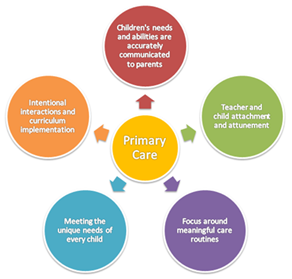Lesson 9: Primary Caregiving and Continuity of Care

Learning Outcomes
Upon completion of this lesson's material, students will be able
- Define primary caregiving and continuity of care.
- Explain the importance of primary caregiving and continuity of care for the child and family.
- Identify challenges in primary caregiving and continuity of care.
- Discuss strategies to build primary caregiver relationships with children and families.
Teaching
Bond and attachment is the number #1 priority when working with infants and toddlers. Without healthy bonds and attachments in early childhood, there can be serious social and emotional consequences later in life. More immediate, the brain development of an infant or toddler can be negatively impacted by lack of healthy bonds and attachments. (see lesson 7)
Many Early Childhood Programs have moved towards something called "continuity of care". This concept recognizes the importance of children having a consistent caregiver (or two) for the first three years of life. In doing so, research has shown that children have better educational and developmental outcomes. This is due to the stable environment and consistent relationship that children can count on. The brain is pattern seeking and feels safe when it can trust. Thus, allowing the brain to focus on other important tasks such as building skills and knowledge that are critical to typical development in all domains.
Through the continuity of care model, a primary caregiver is assigned to the child to focus on what that child needs. This caregiver makes special efforts to bond with the child, plan for the child, meet the child's needs and make the child feel safe. The relationship between the primary caregiver is groomed to be special and impact the child in a positive way that will support and enhance their development. In a site you would see this caregiver being the one that usually feeds the child, changes their diaper, greets the family every morning, and soothes them when they are upset. This doesn't mean that no one else can, it just means that the caregiver is the primary contact for the child and knows the best. For more information about primary caregiving and continuity of care, read pages 76-77 and then 90-91 in the Developmentally Appropriate Practice text.
Primary caregiving is also important for the family. Imagine being a new Mom or Dad and spending the first 6 weeks of your child's life bonding. There is no other comparable even that gives you the same feeling than when your baby grins at you. Now you have to go back to work and let someone take care of him/her!!!! It takes a long time for a parent to build trust with someone who is going to take care of their child. Having one person, that takes the extra time to know your child and family best, makes it easier. We will learn more about family engagement and its important in the next lesson but for this lesson know that primary caregiving is extremely important to the family as well. You are not just building a bond with a baby -- you are building a bond with the family.
Article #2 (provided to you in the CD room in the back of your Developmentally Appropriate Practice text) describes, in more detail, the benefits and advantages of primary caregiving. It also discusses the challenges that come with the responsibility and how to overcome those obstacles. As you read the article, take note on those topics to prepare for the assignment. You can also find more information from ZEROTOTHREE Continuity of Care and Primary Caregiving
Assessment
Lesson 9 Quiz
Answer the following questions with clarity and detailed examples. Each question is worth 20 points
1. What is primary caregiving and continuity of care? How are they different yet similar?
2. Give three main reasons why primary caregiving and continuity of care important for the child.
3. Why is primary caregiving and continuity of care important for the family?
4. Name one challenge to primary caregiving and/or continuity of care and how to overcome the obstacle.
5. Name a second challenge to primary caregiving and/or continuity of care and how to overcome the obstacle.
Lesson 9 Discussion
What do you view is a critical strategy to building a primary caregiver relationship with children and families.